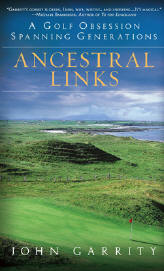Golf Memoir with Multiple Layers
July 3, 2009
There’s something to be said for going on a long walk, with someone else taking the lead.
Your own preference for maintaining a sense of order, of staying on a particular path all the way until its completion, is completely subject to the whims of another.
You’re not sure where you’ll be going next, but you might enjoy the trip all the same.
That’s the sense I had when I completed the meandering path laid by longtime Sports Illustrated writer John Garrity, in his new book, Ancestral Links (New American Library; $24.95 SRP).
Depending on the chapter, this is a travelogue, an autobiography, a study of an American family’s roots, or an elegy for family members who have gone before.
There’s even more to this book, but those are a few of the highlights.
Garrity is part Irish, part Scottish, and all raconteur. The book opens with a funeral ceremony for his father, combined with an altogether different sort of memorial service, held at his father’s old home course in New Richmond, Wisconsin. The action then shifts abruptly to Carne Golf Links, in County Mayo, well north of Galway on Ireland’s west coast.
It seems that the Garrity clan emigrated from that part of Ireland, and so he travels there to see what he can find about his family and why it came to America. It just so happens that Carne is also a beautiful, challenging links course, which Garrity’s older brother Tommy once praised to high heaven.
Tom Garrity, several years older than John, had a short spell on the PGA Tour, and was his younger brother’s idol. In one particularly poignant recollection, Garrity recalls a PGA Tour event in south Florida, when the younger brother lived with their divorced mother, and the older brother drove into town for the tournament. Decades later, Tommy also played Carne, and his reverie about the seventeenth hole inspires John to set a unique scoring goal, using just this one hole for all eighteen.
His repeated attempts form one of the repeating strands throughout the book.
When not trying to break 90 on the seventeenth, Garrity’s continues his search for a connection between his family’s love of golf and their origins in the old country. It takes him through much of northwest Ireland, and also over to Scotland. It seems that his mother was also a very good golfer in her own right. Her side of the family also has an old connection to golf, but in Scotland. Garrity’s efforts in Machrihanish and points west of Edinburgh are less successful than in Ireland, however.
Sprinkled throughout the book are other bits and pieces of his family history, not all of it happy. His parents’ divorce was not accompanied by attempts to make him pick sides, thankfully, but there’s a certain melancholy running through these passages.
On the other hand, the passages dealing with his Irish friends and their lives are often sprightly by comparison. His description of some of the drinking establishments he visits will be completely familiar to readers who also have had a pint or dram in a warm little place in a tiny Irish village—the kind with seven houses, a church, a store, and two pubs.
There’s no one thing to recommend about this intriguing, deeply personal story. None of its parts would have been enough for a book-length treatment. Put together, however, they make for an interesting, often compelling combination, well worth your reading.
A Routine Par
Christopher Merrick sent in a short note about his buddy Dan Iezzi’s recent round at the River Marsh course near Cambridge, Maryland.
Iezzi whipped his 3-wood on the long par-3 17th hole, but it landed in the adjacent river. Iezzi then re-teed, and his next shot rolled right into the cup.
Not your everyday par, but as Merrick also noted, it also won all the bets.
Sometimes it’s just about the number on the card, and not how that number got there.


